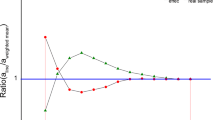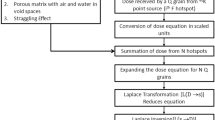Abstract
One of the basic steps in luminescence dating is the determination of the annual radiation dose. Among the suitable determination methods in the case of sediment dating is HPGe gamma-ray spectrometry, primarily yielding the concentrations of K, Th and U via measurement of gamma-rays emitted by 40K and by 232Th and 235,238U and their decay products. These determinations involve both large-volume samples (with cylindrical or Marinelli geometry) and low-energy gamma-rays (down to the 210Pb 46.5 keV line). In view of this, calculations have been made in the present work in order to investigate possible inaccuracies related to gamma-ray attenuation, which may be different in samples and calibrants which have considerably different composition (elemental concentration and packing density). The calculations are based on the introduction of correction factors containing “effective solid angles” (proportional to the peak detection efficiencies), which are believed to give “correct” concentration results. It was found that, in some cases, significant errors could be committed when not performing proper corrections. Therefore, it is concluded that in practice this possible source of inaccuracy should be kept in mind, thus making it necessary to have a fair knowledge of the properties of the materials (samples and calibrants) under investigation.
Similar content being viewed by others
References
M. J. Aitken, Thermoluminescence Dating, Academic Press, New York, 1985.
S. M. Hossain, F. De corte, D. Vandenberghe, P. Van den haute, Nucl. Instr. Meth., A490 (2002) 598.
Preparation and Certification of IAEA Gamma Spectrometry Reference Materials RGU-1, RGTh-1 and RGK-1, Report IAEA/RL/148, Vienna, 1987.
L. Moens, J. De donder, LIN Xilei, F. De corte, A. De wispelaere, A. Simonits, J. Hoste, Nucl. Instr. Meth., 187 (1981) 451.
S. Jovanovit, A. Dlabat, N. Mihaljevit, P. Vukotit, J. Radioanal. Nucl. Chem., 218 (1997) 13.
M. Jurado vargas, A. Fernandez timon, N. Cornejo diaz, D. Perez sanchez, Appl. Radiation Isotopes, 57 (2002) 893.
W. R. Dixon, Nucleonics, 8 (1951) 68.
KAYZERO/SOLCOI Software for Using the k0-Standardization Method, V.5A, Ghent Univ. and DSM Research, 2003.
PHOTKOEF (for Windows), AIC Software, 2000.
Author information
Authors and Affiliations
Rights and permissions
About this article
Cite this article
De Corte, F., Vandenberghe, D., Hossain, S.M. et al. The effect of different sample-calibrant composition in gamma-ray spectrometry for the assessment of the radiation dose rate in the luminescence dating of sediments. Journal of Radioanalytical and Nuclear Chemistry 262, 261–267 (2004). https://doi.org/10.1023/B:JRNC.0000040884.16458.de
Issue Date:
DOI: https://doi.org/10.1023/B:JRNC.0000040884.16458.de




